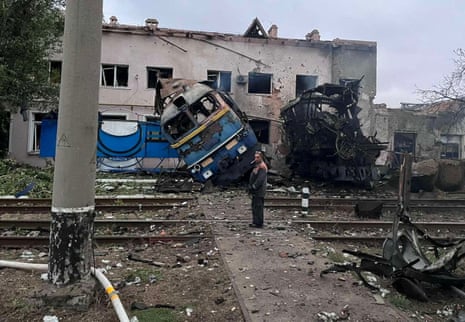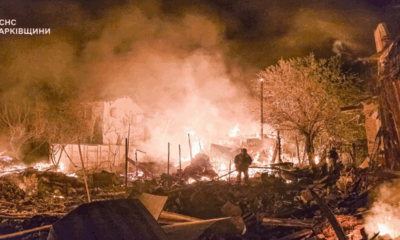World
Russia Intensifies Attacks on Ukrainian Rail Network, Damaging Key Infrastructure

Ukraine has experienced a significant escalation in attacks on its railway system, with a reported threefold increase since July 2025. According to Oleksii Kuleba, Ukraine’s Deputy Prime Minister responsible for infrastructure, these assaults have caused damages amounting to approximately $1 billion (£760 million). The attacks are part of a broader strategy by Moscow to disrupt one of Kyiv’s essential logistical systems.
Kuleba noted that since the beginning of the year, there have been over 800 attacks on railway infrastructure, resulting in damage to more than 3,000 railway objects. “What we have seen in these escalating attacks is that they are going after trains, especially trying to kill the drivers,” he stated. This increase in aggression poses a serious threat to Ukraine, where the railway network is crucial for transporting over 63% of the country’s freight and 37% of passenger traffic, as outlined by the state statistics service.
Targeting Railways: A Strategic Move
The railway system has become a vital artery for military assistance from foreign nations, particularly as no civilian airports have operated since the onset of Russia’s full-scale invasion. Most travel, including visits from world leaders, occurs via train. Oleksandr Pertsovskyi, head of the Ukrainian state railway company, Ukrzaliznytsia, emphasized that the nature of the attacks has evolved. “Now, as they have very precise Shahed drones, they are targeting individual locomotives,” he explained.
To counter these threats, railway authorities have implemented several protective measures. These include equipping trains with electronic systems designed to counter drone strikes and establishing dedicated air defense teams composed of railway staff. Earlier this year, a drone strike heavily damaged the main building at the Lozova station in the Kharkiv region. Other assaults have targeted the rails themselves, causing disruptions.
Despite the dangers, many passengers continue to queue for tickets, determined to travel across the country. Tetyana Tkachenko, the station head at Lozova, recounted a recent attack, stating, “It was night and everyone was sleeping. I woke up from the huge explosion because I live very close to the station. It happened at 2:44 AM. It was clear they were targeting the station. They wanted to do it. And they did it.”
Impact on Infrastructure and Civilian Safety
During a tour of the damaged station, Tkachenko pointed out the destruction, including a damaged platform and a main waiting room rendered unusable. The facade of the building showed signs of severe damage, with a pile of twisted metal left on a disused platform. She explained the strategic importance of Lozova, highlighting its position as a major junction connecting multiple directions, including Dnipro, Sloviansk, Poltava, and Kharkiv. These routes are critical not only for passenger travel but also for freight and military logistics, including the evacuation of injured soldiers from the eastern front.
“The threat these days is really big,” Tkachenko commented, underscoring the direct targeting of civilian gathering places. Oleksandr Podvarchansky, responsible for railway tracks in the Lozova area, described the procedures followed when air raid sirens sound. “Every single air alarm requires us to stop and use a bomb shelter. If there is a train on the tracks, we move it to the nearest station so people can evacuate,” he said.
Kuleba outlined three primary objectives of the Russian attacks: destroying Ukraine’s logistics in the south to hinder the movement of goods to seaports, disrupting rail traffic near the frontlines in regions like Chernihiv and Sumy, and obliterating infrastructure in the Donbas region. The railway network has also been subjected to bomb threat hoaxes, further complicating operations.
While railway tracks can typically be repaired quickly—often within a day, according to Podvarchansky—the damage to rolling stock poses a more significant concern. In a recent interview with the Associated Press, military and drone expert Serhii Beskrestnov explained that trains are particularly vulnerable to drone strikes due to their slower speeds and predictable routes. As the range and sophistication of Russian drones expand, more of the railway network falls within their reach.
“If the Russians keep hitting diesel and electric locomotives, the time will come very soon when the track will still be intact but we’ll have nothing left to run on it,” warned Beskrestnov. The ongoing conflict continues to challenge the resilience of Ukraine’s railway infrastructure and the safety of its operations.
-

 Entertainment3 months ago
Entertainment3 months agoAnn Ming Reflects on ITV’s ‘I Fought the Law’ Drama
-

 Entertainment4 months ago
Entertainment4 months agoKate Garraway Sells £2 Million Home Amid Financial Struggles
-

 Health2 months ago
Health2 months agoKatie Price Faces New Health Concerns After Cancer Symptoms Resurface
-

 Entertainment2 months ago
Entertainment2 months agoCoronation Street’s Carl Webster Faces Trouble with New Affairs
-

 Entertainment2 months ago
Entertainment2 months agoWhere is Tinder Swindler Simon Leviev? Latest Updates Revealed
-

 Entertainment4 months ago
Entertainment4 months agoKim Cattrall Posts Cryptic Message After HBO’s Sequel Cancellation
-

 Science4 weeks ago
Science4 weeks agoBrian Cox Addresses Claims of Alien Probe in 3I/ATLAS Discovery
-

 Entertainment3 months ago
Entertainment3 months agoMarkiplier Addresses AI Controversy During Livestream Response
-

 Entertainment2 months ago
Entertainment2 months agoOlivia Attwood Opens Up About Fallout with Former Best Friend
-

 Entertainment3 months ago
Entertainment3 months agoMasterChef Faces Turmoil as Tom Kerridge Withdraws from Hosting Role
-

 Entertainment4 months ago
Entertainment4 months agoSpeculation Surrounds Home and Away as Cast Departures Mount
-

 World2 months ago
World2 months agoCole Palmer’s Mysterious Message to Kobbie Mainoo Sparks Speculation




















